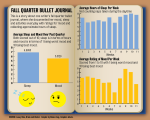Starting last fall quarter, I kept a bullet journal. Created by New York digital product designer Ryder Carroll in 2013, bullet journals have become an uber-trendy, fun and lighthearted lifehack to keep track of one’s physical and mental health throughout the year. Bullet journals track correlations among things like sleep, exercise, food, mood, accomplishments, upsetting events and anything else that could contribute to one’s overall health.
As one can see from the millions of varied versions that show up if you search #bulletjournal on Instagram, there is no one way to record one’s lifestyle. The options listed above are just some suggestions for how to lay out a bullet journal. A bullet journal is catered to you and you specifically. It can be as fancy and aesthetically pleasing as you desire or as simplistic and quick to analyze as you want.
Inspired by how many articles and photos floated around on the internet promoting this idea, I decided to keep my own little bullet journal. It didn’t take too much effort. If anything, it was relaxing and therapeutic to do so as I got to color and draw boxes.
At the end of my tracking, I calculated the average amount of sleep I received as well as my overall mood. Despite some extremes that occurred on certain days, I would roughly get seven hours of sleep each day and my mood would hover just over mediocre at 5.5, with 1 as the worst mood and 10 as the best. I guess it is true that over time, everything moves toward the mean.
It was interesting but not surprising to note that my sleep and mood tended to go down during busier, challenging weeks when midterms, club deadlines and social outings collided. Not only that, I tended to not exercise during these stressful times. Emotions I listed during these days poised more on the negative end and food I ate were less healthy, consisting mostly of snacks.
Basic knowledge from psychology and statistics teaches you that this information from a bullet journal only proves correlation, not causation. But even still, the correlations showed me that doing more of certain activities aligned with my mood improving. The greatest realization, though, is how every day, as I filled in the sections in my bullet journal, I was reminded of just how important it is for me to take care of myself, which is the whole point of keeping one of these journals.
When I had to physically pick up a pencil and write down what had happened to me that day, I was forced to own up to my previously passive mentality about things like exercise, eating healthy and getting enough sleep.
My physical fitness does matter to me. My happiness is essential to me. And as I tracked the hours of sleep I got, the emotions I felt and the food I fed myself, my bullet journal made me remember what is often easy to forget: At the end of the day, a lot of what I make of my life is up to me. It is amazing how when you actually try, whether by getting that extra hour of sleep or cooking yourself an actual meal instead of eating junk food, your mood increases.
As we all try to hold onto our new year’s resolutions, I highly recommend keeping a bullet journal. It is a great way to become self-aware of what contributes to stress, as well as encouraging to be able to monitor one’s growth.
There is no wrong way to keep a bullet journal, but in my opinion, there is a righter way to live, and that is to get motivated and take charge of the areas in your life that you have access to. Winter quarter is notoriously known as the worst quarter of the year. With this first week already piling on the stress, why not try starting a bullet journal to help manage and organize one’s life more efficiently?
